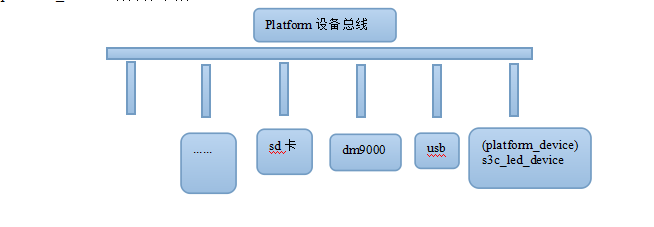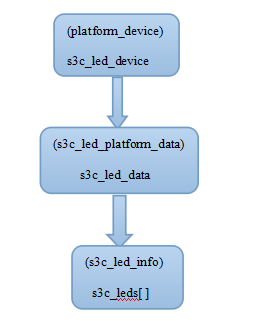首先贴上代码
s3c_driver.h
#ifndef __S3C_DRIVER_H
#define __S3C_DRIVER_H
#include <linux/version.h>
#include <linux/kernel.h>
#include <linux/errno.h>
#include <linux/init.h>
#include <linux/slab.h>
#include <linux/module.h>
#include <linux/kref.h>
#include <linux/spinlock.h>
#include <asm/uaccess.h>
#include <linux/mutex.h>
#include <linux/delay.h>
#include <linux/fs.h>
#include <linux/device.h>
#include <linux/i2c.h>
#include <linux/string.h>
#include <linux/bcd.h>
#include <linux/miscdevice.h>
#include <linux/poll.h>
#include <linux/irq.h>
#include <linux/interrupt.h>
#include <linux/sysfs.h>
#include <linux/proc_fs.h>
#include <linux/rtc.h>
#include <linux/spinlock.h>
#include <linux/usb.h>
#include <asm/uaccess.h>
#include <asm/delay.h>
#include <linux/syscalls.h> /* For sys_access*/
#include <linux/platform_device.h>
#include <linux/unistd.h>
#include <linux/tty.h>
#include <linux/tty_flip.h>
#include <linux/serial.h>
#include <linux/serial_core.h>
#include <linux/irq.h>
#include <mach/regs-gpio.h>
#if LINUX_VERSION_CODE >= KERNEL_VERSION(2,6,32)
#include <mach/hardware.h>
#include <mach/gpio.h>
#include <asm/irq.h>
#else
#include <asm-arm/irq.h>
#include <asm/arch/gpio.h>
#include <asm/arch/hardware.h>
#endif
#include "plat_ioctl.h"
/* ===========================================================================
* S3C24XX device driver common macro definition
*===========================================================================*/
#define ENPULLUP 1
#define DISPULLUP 0
#define HIGHLEVEL 1
#define LOWLEVEL 0
#define INPUT 1
#define OUTPUT 0
#define OFF 0
#define ON 1
#define ENABLE 1
#define DISABLE 0
#define TRUE 1
#define FALSE 0
/* ===========================================================================
* S3C24XX device driver name and Major number define
*===========================================================================*/
#define DEV_LED_NAME "led"
#define DEV_LED_MAJOR 203
#define DEV_BUTTON_NAME "button"
#define DEV_BUTTON_MAJOR "211"
#define DEV_ADC_NAME "adc"
#define DEV_ADC_MAJOR "212"
/* ***** Bit Operate Define *****/
#define SET_BIT(data, i) ((data) |= (1 << (i))) /* Set the bit "i" in "data" to 1 */
#define CLR_BIT(data, i) ((data) &= ~(1 << (i))) /* Clear the bit "i" in "data" to 0 */
#define NOT_BIT(data, i) ((data) ^= (1 << (i))) /* Inverse the bit "i" in "data" */
#define GET_BIT(data, i) ((data) >> (i) & 1) /* Get the value of bit "i" in "data" */
#define L_SHIFT(data, i) ((data) << (i)) /* Shift "data" left for "i" bit */
#define R_SHIFT(data, i) ((data) >> (i)) /* Shift "data" Right for "i" bit */
/* ===========================================================================
* S3C24XX device driver common function definition
*===========================================================================*/
#define SLEEP(x) {DECLARE_WAIT_QUEUE_HEAD (stSleep); if (10 > x) mdelay ((x * 1000)); \
else wait_event_interruptible_timeout (stSleep, 0, (x / 10));}
#define VERSION_CODE(a,b,c) ( ((a)<<16) + ((b)<<8) + (c))
#define DRV_VERSION VERSION_CODE(DRV_MAJOR_VER, DRV_MINOR_VER, DRV_REVER_VER)
#define MAJOR_VER(a) ((a)>>16&0xFF)
#define MINOR_VER(a) ((a)>>8&0xFF)
#define REVER_VER(a) ((a)&0xFF)
#define dbg_print(format,args...) if(DISABLE!=debug) \
{printk("[kernel] ");printk(format, ##args);}
static inline void print_version(int version)
{
#ifdef __KERNEL__
printk("%d.%d.%d\n", MAJOR_VER(version), MINOR_VER(version), REVER_VER(version));
#else
printf("%d.%d.%d\n", MAJOR_VER(version), MINOR_VER(version), REVER_VER(version));
#endif
}
#endif /* __S3C_DRIVER_H */plat_ioctl.h
#ifndef __PLAT_IOCTL_H
#define __PLAT_IOCTL_H
#include <asm/ioctl.h>
/*===========================================================================
* Common ioctl command definition
*===========================================================================*/
#define PLATDRV_MAGIC 0x60
/*===========================================================================
* ioctl command for all the drivers 0x01~0x0F
*===========================================================================*/
/*args is enable or disable*/
#define SET_DRV_DEBUG _IO (PLATDRV_MAGIC, 0x01)
#define GET_DRV_VER _IO (PLATDRV_MAGIC, 0x02)
/*===========================================================================
* ioctl command for few ioctl() cmd driver 0x10~0x2F
*===========================================================================*/
/* LED driver */
#define LED_OFF _IO (PLATDRV_MAGIC, 0x18)
#define LED_ON _IO (PLATDRV_MAGIC, 0x19)
#define LED_BLINK _IO (PLATDRV_MAGIC, 0x1A)
#define ADC_SET_CHANNEL _IO (PLATDRV_MAGIC, 0x1B)
/*===========================================================================
* ioctl command for GPRS driver 0x30~0x4F
*===========================================================================*/
#define GPRS_POWERDOWN _IO (PLATDRV_MAGIC, 0x30)
#define GPRS_POWERON _IO (PLATDRV_MAGIC, 0x31)
#define GPRS_RESET _IO (PLATDRV_MAGIC, 0x32)
#define GPRS_POWERMON _IO (PLATDRV_MAGIC, 0x33)
#define GPRS_CHK_SIMDOOR _IO (PLATDRV_MAGIC, 0x36)
#define GPRS_SET_DTR _IO (PLATDRV_MAGIC, 0x37)
#define GPRS_SET_RTS _IO (PLATDRV_MAGIC, 0x38)
#define GPRS_GET_RING _IO (PLATDRV_MAGIC, 0x39)
#define SET_PWUP_TIME _IO (PLATDRV_MAGIC, 0x3A)
#define SET_PWDOWN_TIME _IO (PLATDRV_MAGIC, 0x3B)
#define SET_RESET_TIME _IO (PLATDRV_MAGIC, 0x3C)
#define GPRS_CHK_MODEL _IO (PLATDRV_MAGIC, 0x3E)
/*===========================================================================
* ioctl command for EEPROM driver 0x50~0x5F
*===========================================================================*/
#define LL_POWEROFF _IO (PLATDRV_MAGIC, 0x50)
#define LL_POWERON _IO (PLATDRV_MAGIC, 0x51)
#define LL_STOP _IO (PLATDRV_MAGIC, 0x52)
#define LL_START _IO (PLATDRV_MAGIC, 0x53)
#define LL_READ _IO (PLATDRV_MAGIC, 0x54)
#define LL_WRITE _IO (PLATDRV_MAGIC, 0x55)
#define LL_DATALOW _IO (PLATDRV_MAGIC, 0x56)
#define LL_ACKNAK _IO (PLATDRV_MAGIC, 0x57)
#endif /* __PLAT_IOCTL_H */
******************************************************************************************************************************************************************
#include "s3c_driver.h"
#define DRV_AUTHOR "Guo Wenxue <guowenxue@gmail.com>"
#define DRV_DESC "S3C24XX LED driver"
/* Driver version*/
#define DRV_MAJOR_VER 1
#define DRV_MINOR_VER 0
#define DRV_REVER_VER 0
#define DEV_NAME DEV_LED_NAME
//#define DEV_MAJOR DEV_LED_MAJOR
#ifndef DEV_MAJOR
#define DEV_MAJOR 0 /* dynamic major by default */
#endif
#define TIMER_TIMEOUT 40
static int debug = DISABLE;
static int dev_major = DEV_MAJOR;
static int dev_minor = 0;
/* ============================ Platform Device part ===============================*/
/* LED hardware informtation structure*/
struct s3c_led_info
{
unsigned char num; /* The LED number */
unsigned int gpio; /* Which GPIO the LED used */
unsigned char active_level; /* The GPIO pin level(HIGHLEVEL or LOWLEVEL) to turn on or off */
unsigned char status; /* Current LED status: OFF/ON */
unsigned char blink; /* Blink or not */
};
/* The LED platform device private data structure */
struct s3c_led_platform_data
{
struct s3c_led_info *leds;
int nleds;
};
/* LED hardware informtation data*/
static struct s3c_led_info s3c_leds[] = {
[0] = {
.num = 1,
.gpio = S3C2410_GPB(5),
.active_level = LOWLEVEL,
.status = OFF,
.blink = ENABLE,
},
[1] = {
.num = 2,
.gpio = S3C2410_GPB(6),
.active_level = LOWLEVEL,
.status = OFF,
.blink = DISABLE,
},
[2] = {
.num = 3,
.gpio = S3C2410_GPB(8),
.active_level = LOWLEVEL,
.status = OFF,
.blink = DISABLE,
},
[3] = {
.num = 4,
.gpio = S3C2410_GPB(10),
.active_level = LOWLEVEL,
.status = OFF,
.blink = DISABLE,
},
};
/* The LED platform device private data */
static struct s3c_led_platform_data s3c_led_data = {
.leds = s3c_leds,
.nleds = ARRAY_SIZE(s3c_leds),
};
struct led_device
{
struct s3c_led_platform_data *data;
struct cdev cdev;
struct class *dev_class;
struct timer_list blink_timer;
} led_device;
static void platform_led_release(struct device * dev)
{
int i;
struct s3c_led_platform_data *pdata = dev->platform_data;
dbg_print("%s():%d\n", __FUNCTION__,__LINE__);
/* Turn all LED off */
for(i=0; i<pdata->nleds; i++)
{
s3c2410_gpio_setpin(pdata->leds[i].gpio, ~pdata->leds[i].active_level);
}
}
static struct platform_device s3c_led_device = {
.name = "s3c_led",
.id = 1,
.dev =
{
.platform_data = &s3c_led_data,
.release = platform_led_release,
},
};
/* ===================== led device driver part ===========================*/
void led_timer_handler(unsigned long data)
{
int i;
struct s3c_led_platform_data *pdata = (struct s3c_led_platform_data *)data;
for(i=0; i<pdata->nleds; i++)
{
if(ON == pdata->leds[i].status)
{
s3c2410_gpio_setpin(pdata->leds[i].gpio, pdata->leds[i].active_level);
}
else
{
s3c2410_gpio_setpin(pdata->leds[i].gpio, ~pdata->leds[i].active_level);
}
if(ENABLE == pdata->leds[i].blink ) /* LED should blink */
{
/* Switch status between 0 and 1 to turn LED ON or off */
pdata->leds[i].status = pdata->leds[i].status ^ 0x01;
}
mod_timer(&(led_device.blink_timer), jiffies + TIMER_TIMEOUT);
}
}
static int led_open(struct inode *inode, struct file *file)
{
struct led_device *pdev ;
struct s3c_led_platform_data *pdata;
pdev = container_of(inode->i_cdev,struct led_device, cdev);
pdata = pdev->data;
file->private_data = pdata;
return 0;
}
static int led_release(struct inode *inode, struct file *file)
{
return 0;
}
static void print_led_help(void)
{
printk("Follow is the ioctl() command for LED driver:\n");
printk("Enable Driver debug command: %u\n", SET_DRV_DEBUG);
printk("Get Driver verion command : %u\n", GET_DRV_VER);
printk("Turn LED on command : %u\n", LED_ON);
printk("Turn LED off command : %u\n", LED_OFF);
printk("Turn LED blink command : %u\n", LED_BLINK);
}
/* compatible with kernel version >=2.6.38*/
static long led_ioctl(struct file *file, unsigned int cmd, unsigned long arg)
{
struct s3c_led_platform_data *pdata = file->private_data;
switch (cmd)
{
case SET_DRV_DEBUG:
dbg_print("%s driver debug now.\n", DISABLE == arg ? "Disable" : "Enable");
debug = (0==arg) ? DISABLE : ENABLE;
break;
case GET_DRV_VER:
print_version(DRV_VERSION);
return DRV_VERSION;
case LED_OFF:
if(pdata->nleds <= arg)
{
printk("LED%ld doesn't exist\n", arg);
return -ENOTTY;
}
pdata->leds[arg].status = OFF;
pdata->leds[arg].blink = DISABLE;
break;
case LED_ON:
if(pdata->nleds <= arg)
{
printk("LED%ld doesn't exist\n", arg);
return -ENOTTY;
}
pdata->leds[arg].status = ON;
pdata->leds[arg].blink = DISABLE;
break;
case LED_BLINK:
if(pdata->nleds <= arg)
{
printk("LED%ld doesn't exist\n", arg);
return -ENOTTY;
}
pdata->leds[arg].blink = ENABLE;
pdata->leds[arg].status = ON;
break;
default:
dbg_print("%s driver don't support ioctl command=%d\n", DEV_NAME, cmd);
print_led_help();
return -EINVAL;
}
return 0;
}
static struct file_operations led_fops = {
.owner = THIS_MODULE,
.open = led_open,
.release = led_release,
.unlocked_ioctl = led_ioctl, /* compatible with kernel version >=2.6.38*/
};
static int s3c_led_probe(struct platform_device *dev)
{
struct s3c_led_platform_data *pdata = dev->dev.platform_data;
int result = 0;
int i;
dev_t devno;
/* Initialize the LED status */
for(i=0; i<pdata->nleds; i++)
{
s3c2410_gpio_cfgpin(pdata->leds[i].gpio, S3C2410_GPIO_OUTPUT);
if(ON == pdata->leds[i].status)
{
s3c2410_gpio_setpin(pdata->leds[i].gpio, pdata->leds[i].active_level);
}
else
{
s3c2410_gpio_setpin(pdata->leds[i].gpio, ~pdata->leds[i].active_level);
}
}
/* Alloc the device for driver */
if (0 != dev_major)
{
devno = MKDEV(dev_major, dev_minor);
result = register_chrdev_region(devno, 1, DEV_NAME);
}
else
{
result = alloc_chrdev_region(&devno, dev_minor, 1, DEV_NAME);
dev_major = MAJOR(devno);
}
/* Alloc for device major failure */
if (result < 0)
{
printk("%s driver can't get major %d\n", DEV_NAME, dev_major);
return result;
}
/* Initialize button structure and register cdev*/
memset(&led_device, 0, sizeof(led_device));
led_device.data = dev->dev.platform_data;
cdev_init (&(led_device.cdev), &led_fops);
led_device.cdev.owner = THIS_MODULE;
result = cdev_add (&(led_device.cdev), devno , 1);
if (result)
{
printk (KERN_NOTICE "error %d add %s device", result, DEV_NAME);
goto ERROR;
}
led_device.dev_class = class_create(THIS_MODULE, DEV_NAME);
if(IS_ERR(led_device.dev_class))
{
printk("%s driver create class failture\n",DEV_NAME);
result = -ENOMEM;
goto ERROR;
}
#if LINUX_VERSION_CODE >= KERNEL_VERSION(2,6,24)
device_create(led_device.dev_class, NULL, MKDEV(dev_major,0), NULL, DEV_NAME);
#else
device_create (led_device.dev_class, NULL, MKDEV(dev_major,0), DEV_NAME);
#endif
/* Initial the LED blink timer */
init_timer(&(led_device.blink_timer));
led_device.blink_timer.function = led_timer_handler;
led_device.blink_timer.data = (unsigned long)pdata;
led_device.blink_timer.expires = jiffies + TIMER_TIMEOUT;//jiffies为当前时间
add_timer(&(led_device.blink_timer));
printk("S3C %s driver version %d.%d.%d initiliazed.\n", DEV_NAME, DRV_MAJOR_VER, DRV_MINOR_VER, DRV_REVER_VER);
return 0;
ERROR:
printk("S3C %s driver version %d.%d.%d install failure.\n", DEV_NAME, DRV_MAJOR_VER, DRV_MINOR_VER, DRV_REVER_VER);
cdev_del(&(led_device.cdev));
unregister_chrdev_region(devno, 1);
return result;
}
static int s3c_led_remove(struct platform_device *dev)
{
dev_t devno = MKDEV(dev_major, dev_minor);
del_timer(&(led_device.blink_timer));
cdev_del(&(led_device.cdev));
for()
device_destroy(led_device.dev_class, devno);
class_destroy(led_device.dev_class);
unregister_chrdev_region(devno, 1);
printk("S3C %s driver removed\n", DEV_NAME);
return 0;
}
static struct platform_driver s3c_led_driver = {
.probe = s3c_led_probe,
.remove = s3c_led_remove,
.driver = {
.name = "s3c_led",
.owner = THIS_MODULE,
},
};
static int __init s3c_led_init(void)
{
int ret = 0;
ret = platform_device_register(&s3c_led_device);
if(ret)
{
printk(KERN_ERR "%s:%d: Can't register platform device %d\n", __FUNCTION__,__LINE__, ret);
goto fail_reg_plat_dev;
}
dbg_print("Regist S3C LED Platform Device successfully.\n");
ret = platform_driver_register(&s3c_led_driver);
if(ret)
{
printk(KERN_ERR "%s:%d: Can't register platform driver %d\n", __FUNCTION__,__LINE__, ret);
goto fail_reg_plat_drv;
}
dbg_print("Regist S3C LED Platform Driver successfully.\n");
return 0;
fail_reg_plat_drv:
platform_driver_unregister(&s3c_led_driver);
fail_reg_plat_dev:
return ret;
}
static void s3c_led_exit(void)
{
dbg_print("%s():%d remove LED platform drvier\n", __FUNCTION__,__LINE__);
platform_driver_unregister(&s3c_led_driver);
dbg_print("%s():%d remove LED platform device\n", __FUNCTION__,__LINE__);
platform_device_unregister(&s3c_led_device);
}
module_init(s3c_led_init);
module_exit(s3c_led_exit);
module_param(debug, int, S_IRUGO);
module_param(dev_major, int, S_IRUGO);
module_param(dev_minor, int, S_IRUGO);
MODULE_AUTHOR(DRV_AUTHOR);
MODULE_DESCRIPTION(DRV_DESC);
MODULE_LICENSE("GPL");
MODULE_ALIAS("platform:S3C24XX_led");当我第一眼看到这个代码的时候我首先是被里面的各种结构体嵌套给弄糊涂了。
简要的分析了一下,结构体嵌套之间的关系,和一些比较难懂的地方,没做太多深入研究。
内核从2.6开始就引用了platform平台总线的概念,其中每个设备的资源用platform_device结构体来描述。(这个图是我自己理解画出来的,很粗糙·-。-)
当你需要加入某个设备的时候,你将其“挂”到platform设备总线上,就是定义一个platform_device的结构体变量,然后再调用platform_add_devices 或platform_device_register向系统中注册设备,前者可以一次性注册多个平台设备。
platform_device结构体
struct platform_device
{
const char * name;//设备名
u32 id;
struct device dev; //设备结构
u32 num_resources;//设备所使用各类资源数量
struct resource * resource;// 资源
};
首先看到我们定义的platform_s3c_led设备的代码
static struct platform_device s3c_led_device =
{
.name = "s3c_led", //驱动结构体里面也有这样一个name,是驱动和设备相互找到自己的一个“重要线索”
.id = 1,
.dev =
{
.platform_data = &s3c_led_data,
.release = platform_led_release,
},
};
上面的.dev中对.platform_data进行了设备的信息转移,这样我们就需要看到我们用来保存信息的结构体static struct s3c_led_platform_data s3c_led_data.
struct s3c_led_platform_data
{
struct s3c_led_info *leds;
int nleds;
};
static struct s3c_led_platform_data s3c_led_data =
{
.leds = s3c_leds,
.nleds = ARRAY_SIZE(s3c_leds),
};
首先定义了一个s3c_led_platform_data的结构体,这个是led设备的私有数据结构体,接着就马上定义了一个此类型结构体变量用来保存我们设备的私有信息。
在这里我们发现里面还有其他的结构体,这个就是这个代码比较难理解的地方,一层一层的结构体进行了嵌套。
struct s3c_led_info 这个结构体是用来保存led硬件设备的信息。
struct s3c_led_info
{
unsigned char num; /* The LED number */
unsigned int gpio; /* Which GPIO the LED used */
unsigned char active_level; /* The GPIO pin level(HIGHLEVEL or LOWLEVEL)to turn on or off */
unsigned char status; /* Current LED status: OFF/ON */
unsigned char blink; /* Blink or not */
};
然后又定义了此结构体的一个数组s3c_leds[ ],这个数组里面保存了具体每盏灯的硬件信息。
然后将信息再转移到s3c_led_data中(一共有几盏灯,每盏灯的具体信息)。
OK上述就是platform_s3c_led_device里面.dev中数据转移的操作。
然后其中还有一个realease的操作,传入了platform_led_release这个函数,这里我感觉转了一点点弯。
static void platform_led_release(struct device * dev)
{
int i;
struct s3c_led_platform_data *pdata = dev->platform_data;
dbg_print("%s():%d\n", __FUNCTION__,__LINE__);
/* Turn all LED off */
for(i=0; i<pdata->nleds; i++)
{
s3c2410_gpio_setpin(pdata->leds[i].gpio, ~pdata->leds[i].active_level);
}
}
里面我个人最难理解的就是里面传地址的那行代码:
struct s3c_led_platform_data *pdata = dev->platform_data;
弄了很久才有一点眉头,让我慢慢跟你解析:
因为这个函数是我们注册成功后才会去调用,当我们注册成功后,这样我们内核中就有了s3c_led_device这样一个结构体了,当你调用这个函数的时候里面的形参是struct device *dev,因为注册过了,所以存在了这里的*dev其实就是&s3c_led_data,系统会自动去调用这个当形参。
struct device *dev =&s3c_led_device->dev;
struct s3c_led_platform_data *pdata =dev->platform_data;
pdata=&s3c_led_data;
接着说platform_driver:
它与设备一样,也是有一条platform平台总线,上面“挂着”设备驱动,并用platform_driver结构体来描述每个驱动。
struct platform_driver
{
int (*probe)(struct platform_device *); //探测函数,在注册平台设备时被调用
int (*remove)(struct platform_device *); //删除函数,在注销平台设备时被调用
void (*shutdown)(struct platform_device *);
int (*suspend)(struct platform_device *, pm_message_t state); //挂起函数,在关机被调用
int (*suspend_late)(struct platform_device *, pm_message_t state);
int (*resume_early)(struct platform_device *);
int (*resume)(struct platform_device *); //恢复函数,在开机时被调用
struct device_driver driver; //设备驱动结构
};
这里我们同样也定义了s3c_led的platform_driver结构体。
static struct platform_driver s3c_led_driver = {
.probe = s3c_led_probe,
.remove = s3c_led_remove,
.driver = {
.name = "s3c_led",
.owner = THIS_MODULE,
},
};
probe函数一般完成硬件设备使能,struct resource的获取以及虚拟地址的动态映射和具体类型设备的注册(因为平台设备只是一种虚拟的设备类型);remove函数完成硬件设备的关闭,struct resource以及虚拟地址的动态映射的释放和具体类型设备的注销。(struct resource是platform_device里面的结构体成员)
Ps:probe函数里面首先是获得设备的私有数据,然后将led状态进行初始化,再申请设备号,接着就是初始化一个cdev传入已经设置好的file operations最后cdev加入内核。
当然probe函数里面的传值跟上面那个platform_led_release函数里面的差不多只是有一点点变化,就是形参要求得不同,我们可以这样理解。
struct platform_device *dev =&s3c_led_device;
struct s3c_led_platform_data *pdata =dev->dev.platform_data;
pdata=&s3c_led_data;
当定义好这2个platform类型的设备和驱动后,我们就需要看其led初始化函数了,里面包含了这2个platform类型的设备和驱动的注册。
static int __init s3c_led_init(void)
{
int ret = 0;
ret = platform_device_register(&s3c_led_device);//将设备加入platform设备总线中
if(ret)
{
printk(KERN_ERR "%s:%d: Can't register platform device %d\n", __FUNCTION__,__LINE__, ret);
goto fail_reg_plat_dev;
}
dbg_print("Regist S3C LED Platform Device successfully.\n");
/*上面首先进行设备的注册*/
ret = platform_driver_register(&s3c_led_driver);//将驱动加入platform设备总线中
if(ret)
{
printk(KERN_ERR "%s:%d: Can't register platform driver %d\n", __FUNCTION__,__LINE__, ret);
goto fail_reg_plat_drv;
}
dbg_print("Regist S3C LED Platform Driver successfully.\n");
/*然后进行的是驱动的注册*/
/*这里需要注意的是我们是先注册设备的,因为驱动注册时需要匹配内核中所以已注册的设备名。*/
return 0;
fail_reg_plat_drv:
platform_driver_unregister(&s3c_led_driver);
fail_reg_plat_dev:
return ret;
}
然后是led卸载模块函数
static void s3c_led_exit(void)
{
dbg_print("%s():%d remove LED platform drvier\n", __FUNCTION__,__LINE__);
platform_driver_unregister(&s3c_led_driver);
dbg_print("%s():%d remove LED platform device\n", __FUNCTION__,__LINE__);
platform_device_unregister(&s3c_led_device);
}
module_init(s3c_led_init);
module_exit(s3c_led_exit);
同样这2个函数都会各自被上面2个宏使用,即加载led设备和驱动和卸载led设备和驱动。
总结:以上是我对platform_led.c里面的我个人认为的必须要理解的难点解析,对于具体的一些操作函数和timer时钟函数,和led闪烁的函数还没去深入研究。
文字肯定都是比较生涩的,我还是最后用图形来总结一下吧。
其实就是设备那个地方的定义了一层又一层的嵌套,比较麻烦。
首先我们定义了一个platform_device结构体类型的s3c_led_device,一个led设备的结构体,然后呢我们需要把灯的数据呀,所以又定义了一s3c_led_platform_data结构体类
型的s3c_led_data用来保存我们灯的数据,当然灯肯定不止一盏啊,所以就需要用数组来保存,而且每盏灯的具体信息也是很多的,所以我们又定义了一个s3c_led_info结构
体类型的s3c_leds[]数组来保存,当然这些结构体要有关联就得互相包含,所以:s3c_led_info包含于s3c_led_platform_data最后再把s3c_led_data的地址传s3c_led_device
里面的void *类型的platform_data,就这样3者互相形参了联系,我个人认为这里就体现了一种编程的一种分类的思想,把很多东西细化一下,方便管理.还有一个难点我在上面也
提到过了,就是注册后,系统调用时数据的传递。
接下来是我将贴出我的实现代码。
























 471
471

 被折叠的 条评论
为什么被折叠?
被折叠的 条评论
为什么被折叠?








